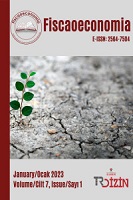The Convergence in Greenhouse Gas Emissions Across G-7 Countries
The Convergence in Greenhouse Gas Emissions Across G-7 Countries
Author(s): Neslihan URSAVAŞ, Şükrü ApaydinSubject(s): Supranational / Global Economy, Energy and Environmental Studies, Economic policy, Environmental and Energy policy, Geopolitics
Published by: Ahmet Arif Eren
Keywords: Convergence Hypothesis; Environmental Convergence Hypothesis; Greenhouse Gas Emissions; Log-t test; G-7 Countries;
Summary/Abstract: Environmental degradation, such as climate crisis, global warming, etc., is one of the crucial issues for countries. Studies in the literature analyze the convergence in environmental degradation regarding the environmental convergence hypothesis using different indicators such as carbon dioxide emissions, ecological footprint, etc. to identify the differences in environmental quality across countries. This study tests the environmental convergence hypothesis for G-7 countries over the period 1997-2018. To do so, we use greenhouse gas emissions per capita as an indicator of environmental degradation and apply non-linear dynamic factor model developed by Phillips & Sul (2007). According to the results, countries do not converge to a single equilibrium point. However, Phillips & Sul (2007) convergence methodology allow us to identify possible convergence clubs. The club clustering algorithm identifies three convergence clubs, each converging to a different steadystate. Club 1, which converges to higher greenhouse gas emissions per capita level, includes Canada and United States, whereas Club 2 includes Germany and Japan, and Club 3 includes France, Italy, and the United Kingdom. The results confirm that the that the environmental convergence hypothesis does not hold for G-7 countries.
Journal: Fiscaoeconomia
- Issue Year: 7/2023
- Issue No: 1
- Page Range: 327-340
- Page Count: 14
- Language: English

